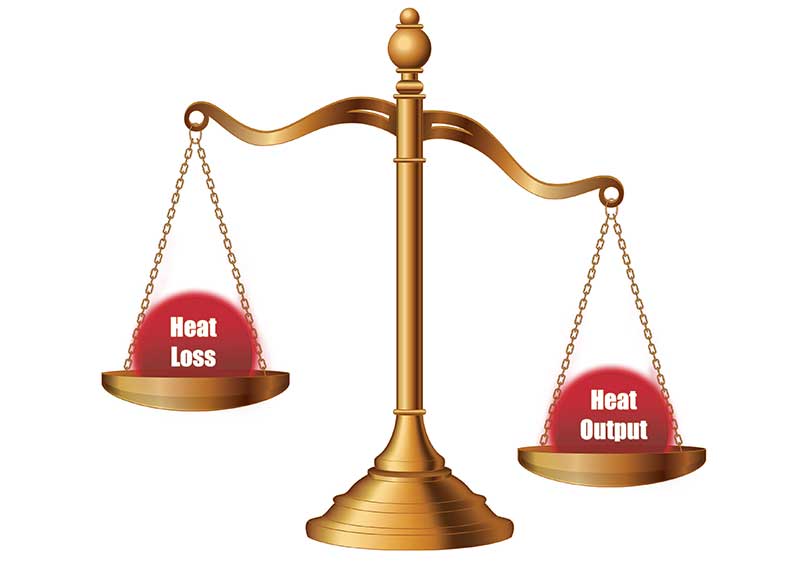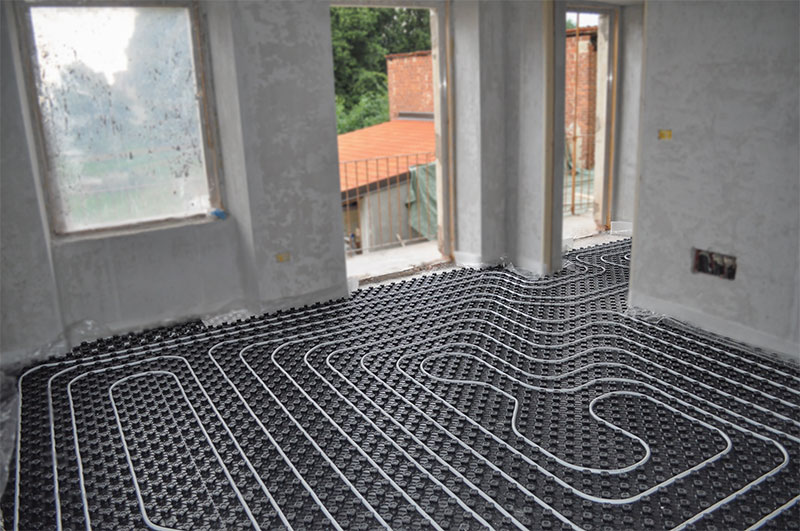Heat loss is a measure of the total transfer of heat through the fabric of a building from inside to the outside, either from conduction, convection, radiation, or any combination of the these. This heat loss figure is normally given in either kilowatts (kW) or British Thermal Units (BTUs) and represents the energy required to keep a room at a given temperature on the coldest days.
Knowing what heat loss is, how to reduce it and what it means when specifying a heating system will help to answer one of the most common questions we get asked: “Will underfloor heating heat my room?“
It is important to understand how heat loss can affect an underfloor heating installation, as a system needs to provide adequate heat to be used as the primary source of heating or enough heat so that it increases comfort when used alongside other heating systems.
We know, and can advise you on, the heat output of an underfloor heating system, but this must be compared to the heat loss of a room in order to ensure that the underfloor heating system specified will provide sufficient heat. Knowing the heat loss in advance allows confidence in choosing a system and knowing that it will work efficiently once installed.
Simply put, in order for an underfloor heating system to provide enough heat to a room, the system output must be greater than the heat loss.
HOW IS HEAT LOSS CALCULATED & WHAT ARE U-VALUES?
As mentioned above, heat loss is measured in kWs or BTUs and is a function of heat transfer rates.
Heat transfer rates in walls, floors and roofs are measured in U values. The U value is the overall heat transfer co-efficient and indicates how well parts of the building transfer heat. A low U value signifies a well-insulated building whereas a high value indicates that the building has a poor thermal performance.
U values are important because they form the basis of any energy or carbon reduction standard. These values determine whether building falls within the regulatory standards. For any building project a regulatory approval must be attained, generally using SAP for residential or SBEM for non-domestic.
To calculate the U value of a building part such as a wall, floor or roof, you need to know the composition and thickness of each part. The other main property you need to obtain is the conductivity or heat transfer measurement of each building material.
WHY IS HEAT LOSS IMPORTANT?
The amount of heat loss is important for several reasons:
- Specifying the type of heating and power requirements to ensure the building is adequately heated
- Understanding whether the building meets regulatory approvals
- Determining whether or not comfort levels can be met for the occupants of the building
- Determining the energy requirements and running costs of the heating system
Above all, it is essential to understand the heat loss of a room or a property before installing underfloor heating as this will ensure that the heating system is able to provide adequate heat.
REDUCING HEAT LOSS & ENERGY CONSUMPTION
There are several ways to reduce energy consumption and heat loss.
These include:
- Improving the insulation of the property (reduction of conduction losses)
- Reducing air leakage (reducing convective losses)
- Reducing energy consumption by using efficient heating methods
The overall heat loss can be decreased by looking at all of the above and by adding insulation or by ensuring that there are no gaps in the existing insulation. For underfloor heating, insulation boards are essential in reducing heat loss to the subfloor and ensuring a fast heat up time.
The underfloor heating insulation boards are quick to install as part of an underfloor heating installation and they cut the heat up time significantly, saving energy and money. For example, on a concrete subfloor the heat up time can be cut from 2.5 hours to as little as 20 minutes.
CHOOSING THE RIGHT UNDERFLOOR HEATING SYSTEM
When buying underfloor heating, heat loss of a building or a room must be taken into consideration as failure to do so may result in the building or room not heating up properly or to the desired comfort levels of the occupants.
Also, installers should also consider whether there is adequate insulation and advise on increasing the insulation, especially when specifying under floor heating. It is usually advisable to specify a certain level of insulation below under floor heating to ensure maximum heat output upwards.
The output of a floor heating system depends on a number of factors, including:
- The overall size of the heated floor area, especially in relation to the overall size of the room. If the heated area is much smaller than the overall floor area (less than 80-90%), then it may be difficult to heat the room with floor heating alone, unless the room itself is very well insulated. In rooms such as bathrooms where the heated floor area can be as little as 50% of the overall area (due to fixtures), we often find that a supplemental heat source such as a towel rail or heated wall is required to reach the desired temperature.
- The type of flooring and the surface temperature of the floor – typically, wood flooring should not be heated above 27°C. As such, the output for a wooden floor is usually lower than that of a tile or stone floor which can have a higher surface temperature (29-30°C).
- Amount of floor insulation – too little insulation results in much of the energy being lost into the subfloor.
- The desired air temperature – the higher the air temperature, the harder it is for a heating system to transfer heat to the air.
- The maximum power of the system – this is normally specified in Watts per square metre. Properly insulated floors in reasonably modern homes require between 65-85W/m² to give the required output, however, a system power of 150-200W/m² is usually specified in order to reduce heat-up times.
ENERGY ASSESSMENT
The heat loss of a building has a significant effect of the Energy Assessment and performance of a building, this is reflected in the Energy Performance Certificate that a building is rated with.
The energy assessor will take into account all the Heat Losses and U values to determine the overall energy assessment of a building. Decreasing heat loss will improve the building performance level.
KEY TAKE OUTS:
- The greater the heat loss, the greater the energy requirement and subsequent running cost
- Always ensure that the heat output from the heater / heating system is greater than the heat loss of the room / building
- Always ensure that the energy requirements of any project fall within regulatory requirements
- New materials are provided with U values for heat loss calculation. However, for older properties, care should be taken to ensure proper assessment of walls, floors, windows and roofs to attain the correct U values. This may require a qualified energy assessment engineer
- It is important to allow some air movement between the inside and outside of the property. This means 2 changes per hour, either through natural means or in a newer, airtight homes, via an air handling system
- The use of an Infra-Red camera can be used to photograph a building externally to identify any potential areas of heat loss
- Reducing heat loss saves money
If you’re looking for an underfloor heating solution and are unsure of whether it will be enough to heat a room in your project, talk to us and we will be able to help you to ensure the system provides efficient heat.




